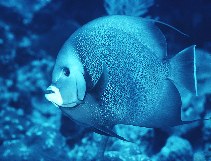http://www.fishbase.org/Summary/speciesSummary.php?genusname=Pomacanthus&speciesname=arcuatus ---> http://192.134.151.83/Summary/speciesSummary.php?genusname=Pomacanthus&speciesname=arcuatus
http://192.134.151.83/Summary/speciesSummary.php?genusname=Pomacanthus&speciesname=arcuatus ---> https://fishbase.mnhn.fr/Summary/speciesSummary.php?genusname=Pomacanthus&speciesname=arcuatus
https://fishbase.mnhn.fr/Summary/speciesSummary.php?genusname=Pomacanthus&speciesname=arcuatus ---> https://fishbase.mnhn.fr/summary/Pomacanthus-arcuatus.html
Pomacanthus arcuatus, Gray angelfish : fisheries, aquarium

You can
sponsor
this page
Common name (e.g. trout)
Genus + Species (e.g. Gadus morhua)
-

-
About this page
-
Languages
-
User feedbacks
-
Citation
-
Uploads
-
Related species
-


 Gray angelfish
Add your observation in
Fish Watcher
Upload your
photos
and
videos
Gray angelfish
Add your observation in
Fish Watcher
Upload your
photos
and
videos
Pictures
|
Videos |
Stamps, Coins Misc.
|
Google image
 Pomacanthus arcuatus
Pomacanthus arcuatus
Picture by
Randall, J.E.
Teleostei (teleosts) >
Acanthuriformes
(Surgeonfishes) >
Pomacanthidae
(Angelfishes)
Etymology:
Pomacanthus:
Greek, poma, -atos = cover, operculum + Greek, akantha = thorn (Ref.
45335
)
.
More on author:
Linnaeus
.
Environment: milieu / climate zone / depth range / distribution range
Ecology
Marine; reef-associated; non-migratory; depth range 2 - 60 m (Ref.
9626
). Tropical; 22°C - 28°C; 44°N - 23°S, 98°W - 34°W
Western Atlantic: New England, USA to the vicinity of Rio de Janeiro, Brazil, including the Gulf of Mexico and the Caribbean (Ref.
26938
).
Length at first maturity / Size / Weight / Age
Maturity: L
m
22.6
range ? - ? cm
Max length : 60.0 cm TL male/unsexed; (Ref.
3797
); common length : 45.0 cm TL male/unsexed; (Ref.
3797
); max. published weight: 1.8 kg (Ref.
40637
)
Dorsal
spines
(total): 9;
Dorsal
soft rays
(total): 31-33;
Anal
spines
: 3;
Anal
soft rays
: 23 - 25. Pale gray around mouth, and pale gray margin on caudal fin. Inside of pectoral fin yellow (Ref.
26938
). Juveniles are black with two light yellow bars on body and three on head; caudal fin yellow with a vertically elongate, nearly rectangular or hemispherical black spot in middle (Ref.
13442
).
Maximum depth from Ref. 126840. Common in coral reefs, usually solitary, occasionally in pairs. Juveniles are part-time cleaners. Feed mainly on sponges, but also takes tunicates, algae, zoantharians, gorgonians, hydroids, bryozoans, and seagrasses. Oviparous (Ref.
240
), monogamous (Ref.
52884
). Flesh reported to be of excellent quality (Ref.
3797
); marketed fresh and salted (Ref.
5217
). Friendly toward divers (Ref.
9710
). Have been reared in captivity (Ref.
35419
).
Life cycle and mating behavior
Maturity
|
Reproduction
|
Spawning
|
Eggs
|
Fecundity
|
Larvae
Monogamous mating is observed as both facultative and social (Ref.
52884
).
Allen, G.R.
, 1985. Butterfly and angelfishes of the world. Vol. 2. 3rd edit. in English. Mergus Publishers, Melle, Germany. (Ref.
4858
)
IUCN Red List Status (Ref.
130435
)
Least Concern (LC)
; Date assessed:
08 October 2009
CITES
Not Evaluated
Not Evaluated
Threat to humans
Reports of ciguatera poisoning (Ref.
30303
)
Human uses
Fisheries: minor commercial; aquarium: commercial
FAO - Publication:
search
|
FishSource
|
Sea Around Us
More information
Countries
FAO areas
Ecosystems
Occurrences
Introductions
Stocks
Ecology
Diet
Food items
Food consumption
Ration
Common names
Synonyms
Metabolism
Predators
Ecotoxicology
Reproduction
Maturity
Spawning
Spawning aggregation
Fecundity
Eggs
Egg development
Age/Size
Growth
Length-weight
Length-length
Length-frequencies
Morphometrics
Morphology
Larvae
Larval dynamics
Recruitment
Abundance
BRUVS
References
Aquaculture
Aquaculture profile
Strains
Genetics
Electrophoreses
Heritability
Diseases
Processing
Nutrients
Mass conversion
Collaborators
Pictures
Stamps, Coins Misc.
Sounds
Ciguatera
Speed
Swim. type
Gill area
Otoliths
Brains
Vision
Tools
Bio-Quiz
|
E-book
|
Field guide
|
Identification keys
|
Length-frequency wizard
|
Life-history tool
|
Point map
|
Classification Tree
|
Catch-MSY
|
Special reports
Check for Aquarium maintenance
|
Check for Species Fact Sheets
|
Check for Aquaculture Fact Sheets
Download XML
Summary page
|
Point data
|
Common names
|
Photos
Internet sources
AFORO (otoliths) |
Alien/Invasive Species database
|
Aquatic Commons
|
BHL
|
Cloffa
|
BOLDSystems
|
Websites from users
|
Check FishWatcher
|
CISTI
|
Catalog of Fishes
:
genus
,
species
|
DiscoverLife
|
DORIS
|
ECOTOX
| FAO - Publication:
search
|
Faunafri
| Fishipedia |
Fishtrace
| GenBank:
genome
,
nucleotide
|
GloBI
|
GoMexSI
(interaction data)
|
Google Books
|
Google Scholar
|
Google
| IGFA World Record |
MitoFish
|
National databases
|
Otolith Atlas of Taiwan Fishes
|
Public aquariums
|
PubMed
|
Reef Life Survey
| Socotra Atlas |
Tree of Life
| Wikipedia:
Go
,
Search
| World Records Freshwater Fishing |
Zoological Record
Estimates based on models
Preferred temperature (Ref.
123201
): 23.8 - 28.1, mean 27.3 °C (based on 849 cells).
Phylogenetic diversity index (Ref.
82804
): PD
50
= 0.5001 [Uniqueness, from 0.5 = low to 2.0 = high].
Bayesian length-weight: a=0.03236 (0.01644 - 0.06368), b=2.90 (2.73 - 3.07), in cm total length, based on LWR estimates for this species & Genus-body shape (Ref.
93245
).
Trophic level (Ref.
69278
): 3.2 ±0.1 se; based on diet studies.
Resilience (Ref.
120179
): Very Low, minimum population doubling time more than 14 years (Preliminary K or Fecundity.).
Fishing Vulnerability (Ref.
59153
): Moderate vulnerability (44 of 100).
Price category (Ref.
80766
):
High
.
Nutrients (Ref.
124155
): Calcium = 31.5 [15.9, 53.1] mg/100g; Iron = 0.459 [0.273, 0.748] mg/100g; Protein = 18.5 [17.3, 19.7] %; Omega3 = 0.085 [0.053, 0.137] g/100g; Selenium = 34.4 [17.3, 66.9] μg/100g; VitaminA = 54.3 [13.7, 197.7] μg/100g; Zinc = 1.1 [0.8, 1.6] mg/100g (wet weight);
Back to Search
Random Species
Back to Top
Accessed through:
Not available
FishBase mirror site :
localhost
Page last modified by :
mrius-barile
- 20 July 2016
Fatal error
: Uncaught ArgumentCountError: Too few arguments to function checkEcotox(), 1 passed in /var/www/html/summary/speciessummary.php on line 2304 and exactly 3 expected in /var/www/html/includes/speciessummary.lib.php:2579 Stack trace: #0 /var/www/html/summary/speciessummary.php(2304): checkEcotox() #1 {main} thrown in
/var/www/html/includes/speciessummary.lib.php
on line
2579
|